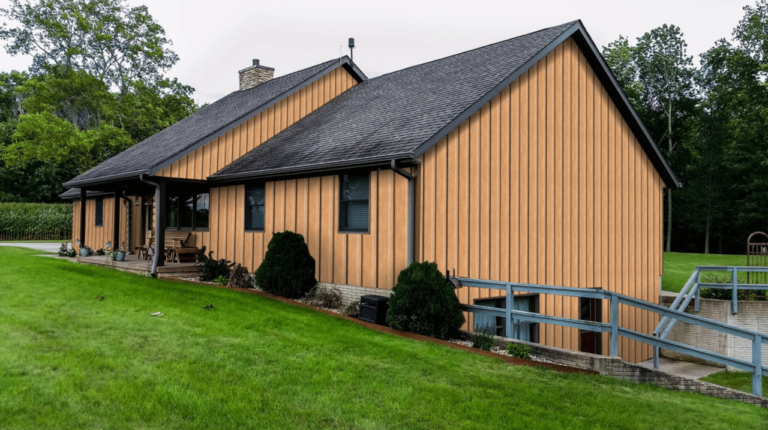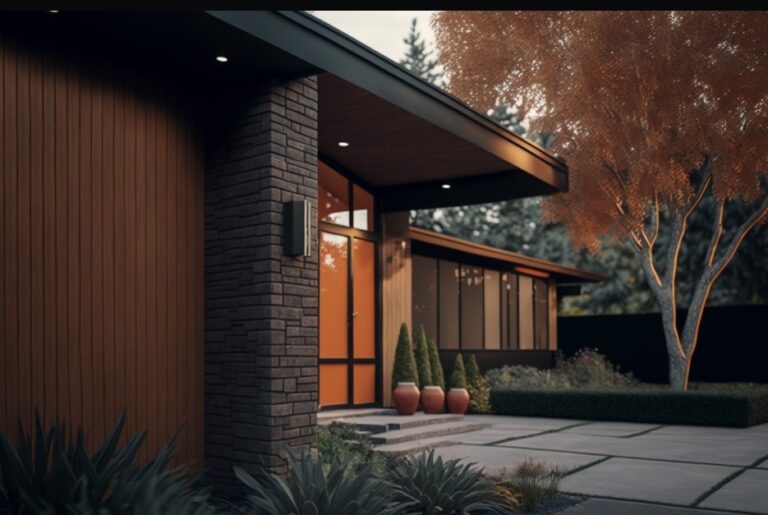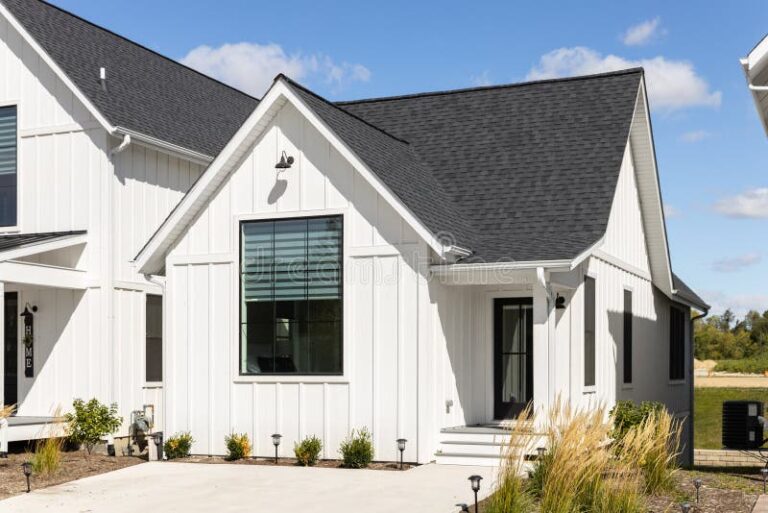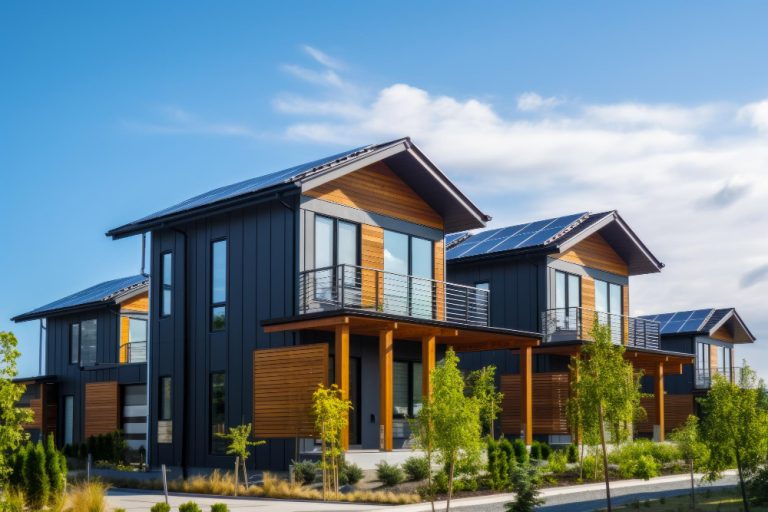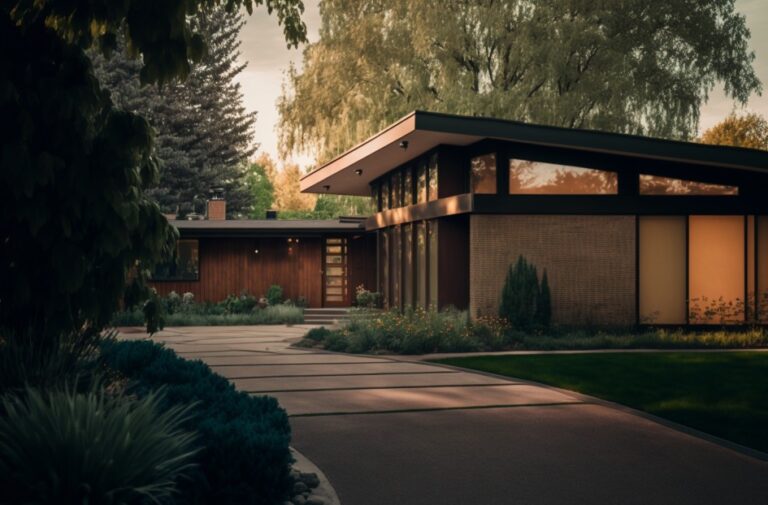Modern Black Siding A Comprehensive Guide
Modern black siding offers a bold and stylish aesthetic for contemporary homes. This comprehensive guide explores the various types of black siding, from durable vinyl to sleek metal, delving into their characteristics, pros, and cons. We’ll also examine design considerations, installation specifics, and the environmental impact of these increasingly popular exterior choices.
From color coordination to energy efficiency, this guide covers the crucial aspects of choosing, installing, and maintaining modern black siding. We’ll look at how different architectural styles can benefit from this dramatic material, along with practical cost considerations and sustainable options. The result is a complete resource for anyone considering black siding for their home or commercial building.
Introduction to Modern Black Siding

Source: imgur.com
Modern black siding is a popular choice for contemporary homes, offering a sleek, sophisticated aesthetic. Its versatility allows architects and homeowners to create visually striking facades while providing lasting protection for the structure. The diverse range of materials available, each with its unique characteristics, contributes to the appeal and practicality of this design element.
Black Siding Materials
Black siding is available in a variety of materials, each with distinct properties. These materials include vinyl, fiber cement, and metal, each presenting different advantages and disadvantages. Understanding these differences is crucial for making informed decisions about the suitability of a specific material for a given project.
Vinyl Siding
Vinyl siding is a popular choice due to its affordability and low maintenance requirements. Its smooth surface and variety of colors, including black, allow for a modern and aesthetically pleasing facade. However, vinyl’s susceptibility to damage from extreme temperatures and impact is a potential drawback. Furthermore, its performance in high-wind conditions may be less robust compared to other materials.
Fiber Cement Siding
Fiber cement siding, composed of Portland cement, cellulose fibers, and other additives, offers a strong, durable option. The material’s resilience to weather and rot makes it a dependable choice. However, its higher initial cost and heavier weight compared to vinyl siding are potential drawbacks.
Metal Siding
Metal siding, including steel and aluminum, provides exceptional durability and longevity. The inherent strength of metal offers significant protection against weather elements. Furthermore, its resistance to fire and insects is a major advantage. However, the potential for noise transmission from rain or wind, and the higher initial cost, should be considered.
Comparison of Black Siding Materials, Modern black siding
| Material | Durability | Maintenance | Cost |
|---|---|---|---|
| Vinyl | Moderate: susceptible to impact and extreme temperatures. | Low: Minimal cleaning required. | Low |
| Fiber Cement | High: resistant to weather and rot. | Moderate; occasional cleaning. | Medium |
| Metal | High: resistant to fire, insects, and weather. | Low: Minimal cleaning required. | High |
This table provides a general overview of the comparative qualities of the three black siding materials. Individual projects may experience variances based on specific conditions and installation practices.
Design Considerations for Black Siding

Black siding, a popular choice for modern homes, offers a striking aesthetic. Its deep, rich tone can dramatically alter the look and feel of a house, creating a contemporary or even a dramatic statement. However, choosing black siding involves careful consideration of the home’s overall design, including its architectural style, surrounding landscape, and desired effect.
Color coordination with other architectural elements is crucial for a harmonious look. A well-balanced color palette creates a cohesive and aesthetically pleasing exterior. This involves understanding how different colors interact, creating a sense of visual unity, and preventing jarring contrasts.
Color Coordination with Architectural Elements
A thoughtful approach to color coordination is vital for maximizing curb appeal. Matching the black siding with the roof, windows, and trim is essential to avoid a chaotic appearance. For instance, a deep charcoal gray roof can complement black siding beautifully, while crisp white trim offers a striking contrast. Windows in a complementary color like bronze or deep green can further enhance the aesthetic harmony. Using black as a dominant color requires a careful balance to avoid overwhelming the house.
Impact on Curb Appeal and Home Value
Black siding can significantly impact curb appeal, adding a modern and sophisticated touch to any home. The sleek, contemporary appearance of black siding often translates to a higher perceived value. However, the effect varies based on the overall design of the home and its location. A well-maintained home with carefully chosen black siding can fetch a higher price in the real estate market compared to a home with poorly coordinated elements.
Design Approaches for Different Architectural Styles
Black siding can be seamlessly integrated into various architectural styles. A modern farmhouse, with its rustic charm, can benefit from a deep black siding that creates a modern contrast against traditional elements. Contemporary homes often embrace the sleekness of black siding, emphasizing its minimalist appeal. Minimalist designs benefit greatly from the bold and clean lines that black siding provides. Black siding can also add a touch of sophistication to Craftsman-style homes.
Selecting a Specific Black Siding Color Shade
Selecting the right black siding shade involves considering various factors. The undertones of the black, such as gray, blue, or brown, will influence the overall look. A black with gray undertones can appear cooler and more modern, while a black with brown undertones might create a warmer ambiance. Factors like the surrounding landscape and the home’s overall design should also be considered. Different shades of black can have subtle differences in appearance, so samples are essential for visual evaluation.
Choosing Black Siding for Location and Climate
The location and climate play a vital role in the choice of black siding. In areas with intense sunlight, a black siding might heat up considerably. This could affect the comfort of the house and potentially require additional measures for insulation. In regions with high rainfall, the ability of the siding to resist water damage is critical. Consider the long-term maintenance requirements and the durability of different black siding materials in your specific climate.
Comparison of Architectural Styles Benefiting from Black Siding
| Architectural Style | Benefits of Black Siding | Considerations |
|---|---|---|
| Modern Farmhouse | Creates a modern contrast against traditional elements, adding a touch of contemporary sophistication. | Ensure the black siding complements the existing rustic features and materials. |
| Contemporary | Emphasizes the minimalist aesthetic, highlighting clean lines and a sleek design. | Avoid overly aggressive contrasts that might detract from the minimalist feel. |
| Minimalist | Provides a bold, clean, and sophisticated appearance. | Careful consideration of other elements is needed to avoid a stark and uninviting look. |
| Craftsman | Adds a touch of sophistication and modern appeal to the traditional design. | The black siding should be chosen carefully to avoid clashing with the existing architectural style. |
Installation and Maintenance of Black Siding
Modern black siding offers a sleek aesthetic and durability, but its installation and maintenance require careful consideration. Proper installation is crucial for long-term performance, while diligent maintenance ensures the siding retains its appearance and structural integrity. This section details the essential steps and considerations for the successful installation and ongoing care of your black siding.
Installation Procedure
The installation of black siding should be undertaken by qualified professionals, following manufacturer’s instructions. Safety precautions are paramount during all phases of installation. This includes using appropriate fall protection equipment when working at heights and ensuring proper ventilation.
- Preparation: Thoroughly inspect the existing structure to ensure it is sound and suitable for the new siding. Identify any areas needing repair or reinforcement before commencing the installation. Ensure all necessary permits are obtained. Verify the weather conditions to avoid working in inclement weather.
- Framing and Flashing: Ensure the underlying framing is correctly sized and securely attached. Install flashing at all critical points, such as around windows and doors, to prevent water penetration. This is a critical step to prevent future issues like rot and mold.
- Siding Application: Adhere to the manufacturer’s instructions regarding the specific adhesive and installation techniques. Follow the recommended overlap patterns and secure the siding panels to the framing with the appropriate fasteners. Ensure proper spacing between panels for expansion and contraction.
- Finishing Touches: Caulk all gaps and seams to create a watertight seal. Inspect the completed installation for any imperfections or damage. Clean any debris or residue from the siding and ensure proper drainage around the house.
Required Tools and Equipment
A comprehensive list of tools is essential for a smooth installation process.
- Measuring tools: Tape measures, a level, and a framing square are crucial for precise measurements and accurate installation.
- Power tools: Electric drills, saws, and nail guns will significantly expedite the installation process.
- Hand tools: Hammers, screwdrivers, and pliers are essential for the finer aspects of the installation.
- Safety equipment: Safety glasses, gloves, and work boots are necessary for personal protection. Fall protection equipment may be required for higher-level installations.
Ventilation and Drainage
Proper ventilation and drainage are vital for preventing moisture damage to the siding and the underlying structure.
- Airflow: Ensure proper attic ventilation to prevent moisture buildup behind the siding. This is especially important in humid climates. Adequate soffit and fascia ventilation can also help.
- Drainage: Install gutters and downspouts to direct water away from the foundation and siding. Ensure proper grading around the house to allow water to flow away from the structure.
Long-Term Maintenance
Regular maintenance ensures the longevity and aesthetic appeal of black siding.
- Inspections: Regularly inspect the siding for any signs of damage, such as cracks, gaps, or loose fasteners. Address any issues promptly.
- Cleaning: Clean the siding regularly, especially in areas prone to dirt accumulation. Use a soft brush and mild detergent to prevent damage to the siding.
- Protection: Consider using a sealant or protective coating to enhance longevity and resistance to weathering. This is particularly helpful for maintaining the black color.
Typical Lifespan of Black Siding
The lifespan of black siding varies based on the material and quality.
| Siding Material | Typical Lifespan (Years) |
|---|---|
| Vinyl | 20-30 |
| Fiber Cement | 50-75 |
| Wood | 15-25 (with proper maintenance) |
Note: These are estimates and actual lifespan can vary based on environmental factors, maintenance, and quality of installation.
Applications and Examples of Black Siding
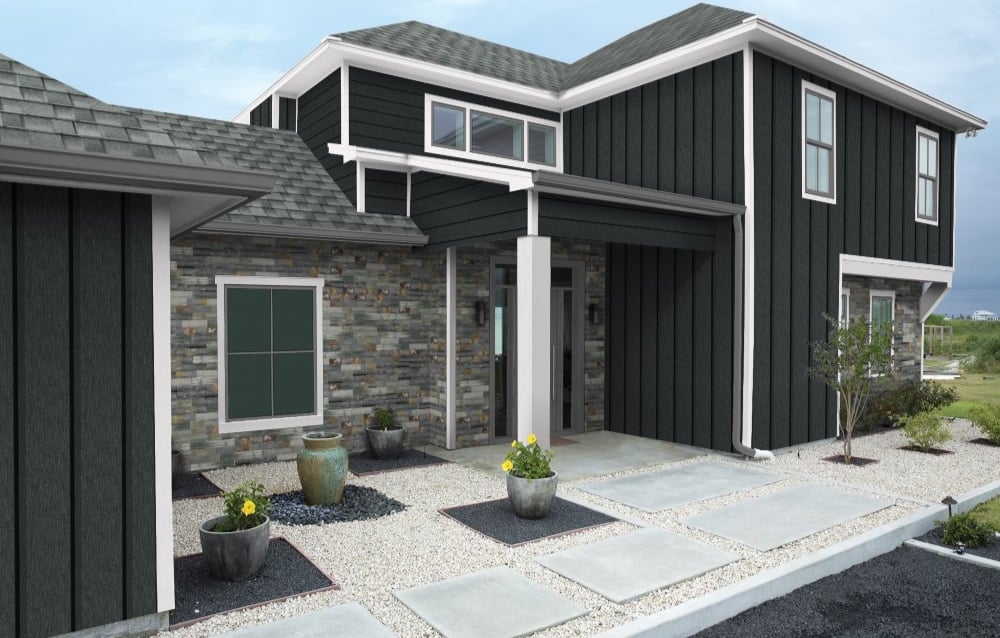
Black siding, with its striking aesthetic, offers a versatile solution for enhancing the exterior of homes and commercial buildings. Its dramatic presence can dramatically transform a structure’s appearance, and its ability to complement various roofing materials and architectural styles makes it a popular choice for modern design. This section will explore diverse applications of black siding, demonstrating its integration into residential and commercial projects.
Black siding can significantly impact the overall visual appeal of a home or building. Its deep, rich tone can create a sophisticated and modern look, often contrasting beautifully with other materials like light-colored stone, brick, or landscaping. The section that follows highlights how this striking siding material can be utilized in various settings.
Integration with Different Roofing Materials
Black siding effectively pairs with a range of roofing materials. The visual harmony between the black siding and roofing depends heavily on the color and material of the roofing. For instance, a metal roof, especially in a dark gray or charcoal hue, can create a cohesive and modern aesthetic when paired with black siding. Conversely, black siding can also provide a striking contrast against a traditional asphalt shingle roof, adding a contemporary touch to a more traditional home.
Examples of Residential Homes
Numerous residential homes feature black siding, showcasing its adaptability to various architectural styles. A modern farmhouse design might incorporate black siding with a light-colored stone foundation, creating a striking contrast. A contemporary home with a flat roof and large windows can use black siding to accentuate its clean lines and minimalist aesthetic. A Craftsman-style home with exposed beams and natural wood accents can benefit from black siding to provide a bold, contemporary contrast. In a coastal setting, black siding can offer a dramatic focal point, while a rustic cabin design can use black siding in combination with natural materials for a striking contrast.
Commercial Building Applications
Black siding is not limited to residential applications. Commercial buildings, such as retail stores, offices, and restaurants, can also benefit from the aesthetic appeal and durability of black siding. The dark tone can create a sophisticated and modern presence, particularly for businesses aiming for a contemporary image. The durability of black siding can be a significant advantage for commercial buildings, especially those located in areas with harsh weather conditions.
Impact on Exterior Lighting
| Lighting Scenario | Impact on Black Siding |
|---|---|
| Bright Sunlight | Black siding absorbs sunlight, potentially increasing surface temperature. This may necessitate the consideration of shading or insulation strategies. |
| Dim Light | Black siding can absorb ambient light, potentially creating a darker overall visual impact. This may require strategic lighting design. |
| Night Lighting | Black siding can be effectively highlighted by strategic outdoor lighting, emphasizing its depth and texture. Consider using warm-toned or cool-toned lights to create different effects. |
Black siding can absorb light and heat, which can affect the surrounding environment. Strategically designed lighting can counteract these effects. Appropriate lighting can highlight the textures and depths of the siding, creating a more visually appealing exterior.
Creating Depth and Dimension
Black siding can be used to create a sense of depth and dimension in a home’s exterior. This is often achieved by combining different textures, such as smooth and rough surfaces. Using varying shades of black, such as deep blacks and slightly lighter shades, can also enhance the sense of depth. By strategically placing accents, such as dark window frames or trim, around the home, black siding can visually delineate different areas and create a sense of architectural interest.
Environmental and Sustainability Aspects
Choosing black siding involves more than aesthetics; its environmental impact is a crucial consideration. Different materials have varying levels of embodied energy, recyclability, and long-term sustainability. Understanding these factors helps homeowners make informed decisions aligned with eco-conscious values.
Environmental Impact of Different Black Siding Materials
Various materials used for black siding exhibit diverse environmental footprints. The manufacturing process of vinyl siding, for example, often involves the use of fossil fuels and can generate greenhouse gas emissions. Conversely, reclaimed wood siding, while aesthetically pleasing, might have a high transportation cost, impacting the overall carbon footprint. The sourcing and production methods significantly influence the environmental impact.
Recyclability and Reusability of Black Siding Options
The recyclability of black siding materials varies. Some, like vinyl, are readily recyclable, while others, such as certain types of composite siding, are less easily recycled. Moreover, the reusability of salvaged or reclaimed materials is also a key factor. Proper disposal and recycling practices are essential to minimize environmental harm. Incorporating recycled content in siding production can further enhance sustainability.
Energy Efficiency Benefits of Black Siding in Various Climates
Black sidings absorb solar radiation, which can influence energy efficiency. In climates with abundant sunlight, this can lead to higher indoor temperatures, potentially increasing energy consumption for cooling. Conversely, in colder regions, the absorbed solar energy might provide some passive heating in winter, potentially reducing energy consumption for heating. The net energy impact depends on the specific climate and the design of the building.
Minimizing the Environmental Footprint During Installation and Maintenance
Minimizing the environmental footprint during installation and maintenance is crucial. Using recycled materials in construction and choosing installers with environmentally sound practices contribute significantly. Proper waste management during installation and responsible disposal of old siding materials are vital steps. Regular maintenance, preventing premature replacement, extends the lifespan of the siding and reduces waste.
Table Illustrating the Carbon Footprint of Different Black Siding Materials
| Siding Material | Estimated Carbon Footprint (kg CO2e per square meter) | Sustainability Features |
|---|---|---|
| Vinyl Siding (recycled content) | 15-25 | Readily recyclable, low embodied energy (when recycled content is high) |
| Composite Siding (recycled content) | 20-30 | Potentially recyclable, depending on the composite material’s composition |
| Reclaimed Wood Siding | 25-45 | Sustainable if sourced responsibly, often requires high transportation |
| Steel Siding | 10-20 | Recyclable, relatively low embodied energy |
Note: Carbon footprint estimates are approximate and may vary based on production processes, transportation distances, and regional factors.
Sustainability Features of Different Black Siding Options
The sustainability of black siding choices hinges on several factors. Recycled content in vinyl or composite siding is a positive indicator. The sourcing and manufacturing processes of wood siding also significantly impact sustainability. Consider the embodied energy, recyclability, and longevity of each material when making a choice. The use of locally sourced materials, for example, can reduce transportation-related emissions.
Cost and Budget Considerations: Modern Black Siding

Source: gambrick.com
Black siding, while aesthetically pleasing, presents a range of cost considerations. Understanding the factors influencing price is crucial for homeowners to make informed decisions aligned with their budgets. This section details typical cost ranges, installation factors, and methods for comparing options based on value.
Typical Cost Ranges for Different Black Siding Materials
Various black siding materials offer distinct price points. Vinyl siding, a popular choice due to its affordability and durability, generally falls within a lower cost range. Fiber cement siding, known for its longevity and resistance to weathering, usually carries a higher price tag. Steel siding, offering a strong and durable option, typically sits between vinyl and fiber cement in cost. Wood siding, though visually appealing, can have a significantly higher price compared to other materials due to its material cost and labor-intensive installation process.
Factors Influencing Black Siding Installation Costs
Several factors contribute to the overall installation cost beyond material expenses. These include the size of the home’s exterior requiring siding, the complexity of the design, and the type of labor involved. Specialized installation requirements, such as complex architectural features or unusual siding patterns, often lead to higher labor costs. Furthermore, geographical location and the availability of skilled labor can also affect the final price.
Comparing Black Siding Options Based on Cost and Value
Comparing different black siding options requires a thorough assessment of cost and value. A critical element in this evaluation is considering the long-term return on investment. Vinyl siding, though initially more affordable, might require replacement more frequently than higher-cost alternatives like fiber cement, which offers a longer lifespan. Estimating the total cost over the siding’s lifespan, factoring in potential maintenance and replacement expenses, provides a more complete cost picture.
Potential Cost Savings
Several methods can help reduce the overall cost of black siding. Choosing a material with a proven track record of longevity can minimize future replacement expenses. Using pre-fabricated components or modular systems during installation can potentially reduce labor costs. Furthermore, obtaining quotes from multiple contractors and comparing their services and pricing provides opportunities for identifying cost-effective options.
Cost Comparison Table
| Siding Material | Material Cost (per square foot) | Labor Cost (per square foot) | Total Estimated Cost (per square foot) |
|---|---|---|---|
| Vinyl | $3 – $8 | $5 – $10 | $8 – $18 |
| Fiber Cement | $10 – $20 | $6 – $12 | $16 – $32 |
| Steel | $8 – $15 | $6 – $11 | $14 – $26 |
| Wood | $12 – $25 | $8 – $15 | $20 – $40 |
Estimated Costs per Square Foot
The table below provides estimated costs per square foot for various black siding options, encompassing material and labor costs. These estimates serve as general guidelines and can vary based on specific project requirements. For instance, the addition of complex architectural features will increase the total cost.
| Siding Material | Estimated Cost per Square Foot |
|---|---|
| Vinyl | $10 – $20 |
| Fiber Cement | $20 – $35 |
| Steel | $15 – $25 |
| Wood | $25 – $45 |
Ultimate Conclusion
In conclusion, modern black siding is a versatile and impactful choice for homeowners and architects alike. This guide has highlighted the diverse options available, the crucial design considerations, and the practical steps for installation and maintenance. By carefully weighing the various factors, from material durability to cost-effectiveness and environmental impact, you can make informed decisions to select the perfect black siding for your project. Ultimately, the right choice will elevate your home’s aesthetic appeal, increase its value, and stand the test of time.
